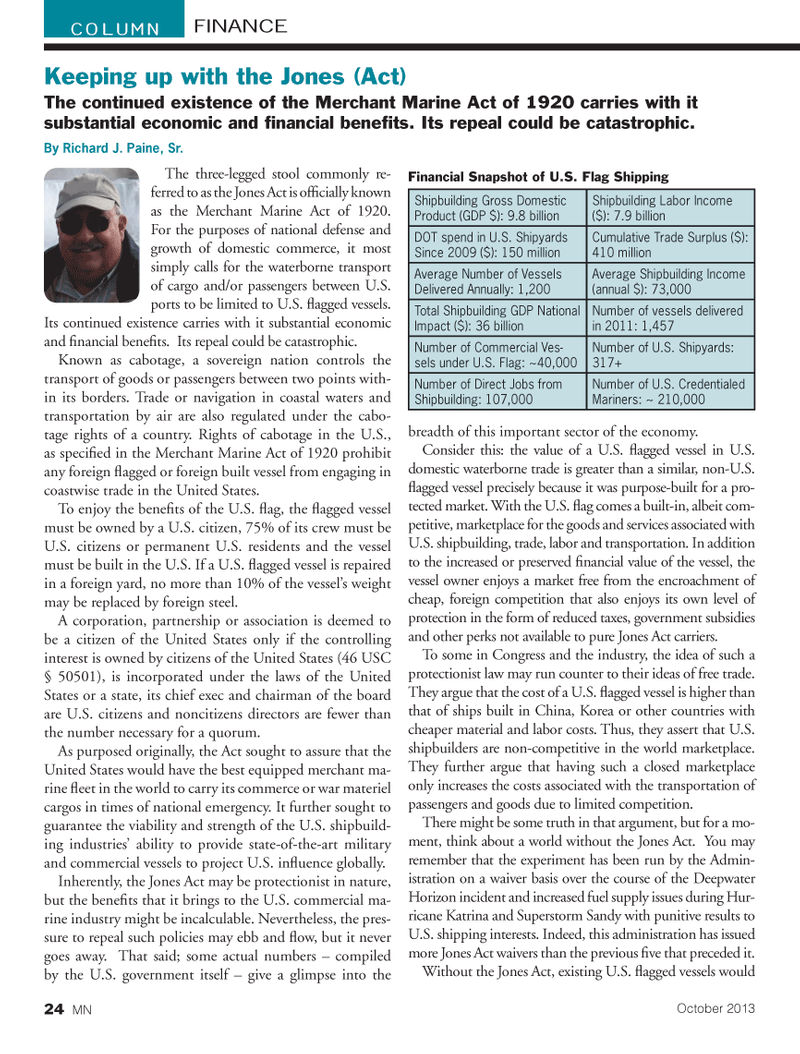
Page 24: of Marine News Magazine (October 2013)
Manning: Recruitment & Retention
Read this page in Pdf, Flash or Html5 edition of October 2013 Marine News Magazine
The three-legged stool commonly re- ferred to as the Jones Act is ofÞ cially known as the Merchant Marine Act of 1920. For the purposes of national defense and growth of domestic commerce, it most simply calls for the waterborne transport of cargo and/or passengers between U.S. ports to be limited to U.S. ß agged vessels. Its continued existence carries with it substantial economic and Þ nancial beneÞ ts. Its repeal could be catastrophic. Known as cabotage, a sovereign nation controls the transport of goods or passengers between two points with- in its borders. Trade or navigation in coastal waters and transportation by air are also regulated under the cabo- tage rights of a country. Rights of cabotage in the U.S., as speciÞ ed in the Merchant Marine Act of 1920 prohibit any foreign ß agged or foreign built vessel from engaging in coastwise trade in the United States. To enjoy the beneÞ ts of the U.S. ß ag, the ß agged vessel must be owned by a U.S. citizen, 75% of its crew must be U.S. citizens or permanent U.S. residents and the vessel must be built in the U.S. If a U.S. ß agged vessel is repaired in a foreign yard, no more than 10% of the vesselÕs weight may be replaced by foreign steel. A corporation, partnership or association is deemed to be a citizen of the United States only if the controlling interest is owned by citizens of the United States (46 USC ¤ 50501), is incorporated under the laws of the United States or a state, its chief exec and chairman of the board are U.S. citizens and noncitizens directors are fewer than the number necessary for a quorum. As purposed originally, the Act sought to assure that the United States would have the best equipped merchant ma- rine ß eet in the world to carry its commerce or war materiel cargos in times of national emergency. It further sought to guarantee the viability and strength of the U.S. shipbuild- ing industriesÕ ability to provide state-of-the-art military and commercial vessels to project U.S. inß uence globally. Inherently, the Jones Act may be protectionist in nature, but the beneÞ ts that it brings to the U.S. commercial ma- rine industry might be incalculable. Nevertheless, the pres- sure to repeal such policies may ebb and ß ow, but it never goes away. That said; some actual numbers Ð compiled by the U.S. government itself Ð give a glimpse into the breadth of this important sector of the economy. Consider this: the value of a U.S. ß agged vessel in U.S. domestic waterborne trade is greater than a similar, non-U.S. ß agged vessel precisely because it was purpose-built for a pro- tected market. With the U.S. ß ag comes a built-in, albeit com- petitive, marketplace for the goods and services associated with U.S. shipbuilding, trade, labor and transportation. In addition to the increased or preserved Þ nancial value of the vessel, the vessel owner enjoys a market free from the encroachment of cheap, foreign competition that also enjoys its own level of protection in the form of reduced taxes, government subsidies and other perks not available to pure Jones Act carriers. To some in Congress and the industry, the idea of such a protectionist law may run counter to their ideas of free trade. They argue that the cost of a U.S. ß agged vessel is higher than that of ships built in China, Korea or other countries with cheaper material and labor costs. Thus, they assert that U.S. shipbuilders are non-competitive in the world marketplace. They further argue that having such a closed marketplace only increases the costs associated with the transportation of passengers and goods due to limited competition. There might be some truth in that argument, but for a mo- ment, think about a world without the Jones Act. You may remember that the experiment has been run by the Admin- istration on a waiver basis over the course of the Deepwater Horizon incident and increased fuel supply issues during Hur- ricane Katrina and Superstorm Sandy with punitive results to U.S. shipping interests. Indeed, this administration has issued more Jones Act waivers than the previous Þ ve that preceded it. Without the Jones Act, existing U.S. ß agged vessels would Keeping up with the Jones (Act) The continued existence of the Merchant Marine Act of 1920 carries with it substantial economic and Þ nancial beneÞ ts. Its repeal could be catastrophic. By Richard J. Paine, Sr. FINANCECOLUMNShipbuilding Gross Domestic Product (GDP $): 9.8 billion Shipbuilding Labor Income ($): 7.9 billionDOT spend in U.S. Shipyards Since 2009 ($): 150 millionCumulative Trade Surplus ($): 410 millionAverage Number of Vessels Delivered Annually: 1,200 Average Shipbuilding Income (annual $): 73,000Total Shipbuilding GDP National Impact ($): 36 billionNumber of vessels delivered in 2011: 1,457Number of Commercial Ves- sels under U.S. Flag: ~40,000Number of U.S. Shipyards: 317+Number of Direct Jobs from Shipbuilding: 107,000Number of U.S. Credentialed Mariners: ~ 210,000Financial Snapshot of U.S. Flag ShippingOctober 201324 MNMN October2013 Layout 18-31.indd 24MN October2013 Layout 18-31.indd 249/30/2013 11:24:18 AM9/30/2013 11:24:18 AM

 23
23

 25
25
